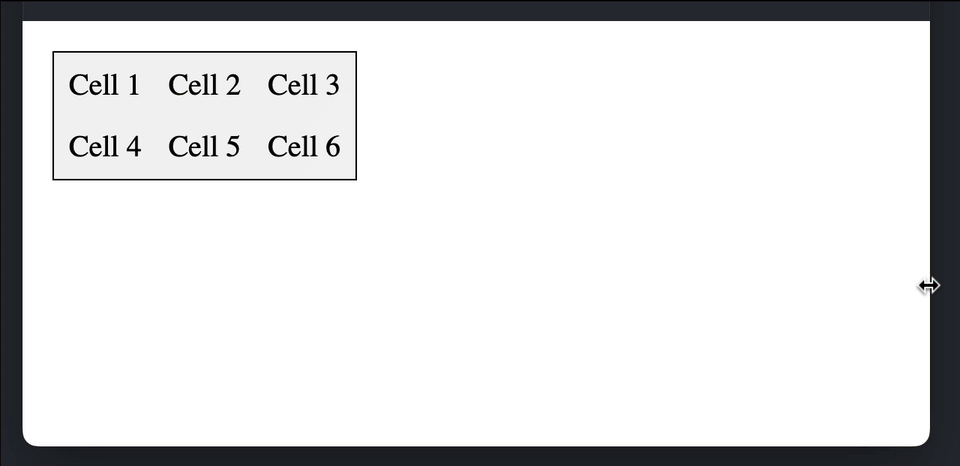HTML tables are supposed for displaying tabular knowledge on an internet web page. They’re nice for displaying data in an organized approach, and might be styled with CSS to match the appear and feel of our web site. On this tutorial, we’ll cowl the fundamentals of making HTML tables and including types to make them responsive and mobile-friendly.
Creating an HTML Desk
To create an HTML desk, we have to use the <desk> tag. Contained in the <desk> tag, we have to create a number of <tr> tags, which outline every row of the desk. Inside every <tr> tag, we will create a number of <td> tags, which outline the cells of the desk. Right here’s an instance of a fundamental HTML desk:
<desk>
<tr>
<td>Cell 1</td>
<td>Cell 2</td>
<td>Cell 3</td>
</tr>
<tr>
<td>Cell 4</td>
<td>Cell 5</td>
<td>Cell 6</td>
</tr>
</desk>
This can create a desk with two rows and three columns, with every cell displaying its contents.
See the Pen
A fundamental HTML desk by SitePoint (@SitePoint)
on CodePen.
Including Rows and Columns
So as to add new rows to the desk, we merely must create a brand new <tr> tag. So as to add new cells to the desk, we will create a brand new <td> tag inside an present <tr> tag. Right here is an instance of a desk with 4 rows and three columns:
<desk>
<tr>
<td>Cell 1</td>
<td>Cell 2</td>
<td>Cell 3</td>
</tr>
<tr>
<td>Cell 4</td>
<td>Cell 5</td>
<td>Cell 6</td>
</tr>
<tr>
<td>Cell 7</td>
<td>Cell 8</td>
<td>Cell 9</td>
</tr>
<tr>
<td>Cell 10</td>
<td>Cell 11</td>
<td>Cell 12</td>
</tr>
</desk>
This can create a desk with 4 rows and three columns.
Styling HTML Tables
HTML tables might be styled utilizing CSS to vary their look. Among the most typical CSS properties used to fashion tables embody border, padding, and background-color. Right here’s an instance of how one can fashion a desk with a border and a background shade:
desk {
border: 1px stable black;
background-color: #f2f2f2;
}
td {
padding: 8px;
}
This can create a desk with a black border and a lightweight grey background shade, with every cell having a padding of eight pixels.
See the Pen
A fundamental HTML desk by SitePoint (@SitePoint)
on CodePen.
Making Tables Responsive and Cellular-friendly
One of many challenges of utilizing HTML tables is making them responsive and mobile-friendly. One strategy to accomplish that is to make use of CSS to regulate the structure of the desk based mostly on the scale of the display. One method is to make use of the show property to vary the structure of the desk from a hard and fast structure to a responsive structure. This may be accomplished utilizing media queries to focus on particular display sizes. Right here’s an instance of how one can make a desk responsive:
desk {
border: 1px stable black;
background-color: #f2f2f2;
}
td {
padding: 8px;
}
@media solely display and (max-width: 600px) {
desk {
show: block;
}
td {
show: block;
}
}
This can make the desk structure change from a hard and fast structure to a responsive structure when the display width is lower than 600 pixels.

See the Pen
A responsive HTML desk with fundamental styling by SitePoint (@SitePoint)
on CodePen.
Including Captions and Summaries
One other necessary side of utilizing HTML tables is making them accessible to non-visual customers. A technique to do that is so as to add captions and summaries to the desk. The <caption> tag can be utilized so as to add a caption to the desk, which describes the content material of the desk. Right here’s an instance of how one can add a caption to a desk:
<desk>
<caption>Gross sales by Month</caption>
<tr>
<th>Month</th>
<th>Gross sales</th>
</tr>
<tr>
<td>January</td>
<td>$1000</td>
</tr>
<tr>
<td>February</td>
<td>$1500</td>
</tr>
</desk>
This can add a caption to the desk, stating that it shows gross sales by month. The <abstract> tag can be utilized to offer a abstract of the desk for display readers and different assistive applied sciences. Right here’s an instance of how one can add a abstract to a desk:
<desk abstract="Gross sales by Month">
<tr>
<th>Month</th>
<th>Gross sales</th>
</tr>
<tr>
<td>January</td>
<td>$1000</td>
</tr>
<tr>
<td>February</td>
<td>$1500</td>
</tr>
</desk>
This can present a abstract of the desk for display readers and different assistive applied sciences, stating that it shows gross sales by month.
Is Utilizing Tables Unhealthy?
No! Tables are an necessary a part of HTML. They’re are important for displaying tabular knowledge in a semantic and accessible approach. Within the early days of the Internet, earlier than the arrival of CSS, tables provided a way to put out net web page designs, however this wasn’t their supposed purose. Fortunately, these days are approach behind us (properly, largely, however for some e mail purchasers!), and we will now deal with the true — and very necessary — position of HTML tables for displaying knowledge.
Conclusion
HTML tables are a robust device for displaying tabular knowledge on an internet web page. With CSS, tables might be styled to match the appear and feel of our web site, and made responsive and mobile-friendly for customers on totally different units. Including captions and summaries to tables can assist enhance accessibility for customers with disabilities. With these strategies, we will create efficient tables which can be each visually interesting and useful.


